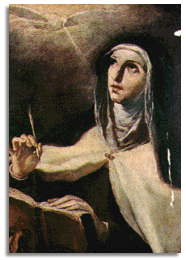Let nothing disturb you.
Let nothing make you afraid.
All things are passing.
God alone never changes.
Patience gains all things.
If you have God you will want for nothing.
God alone suffices.
Today, October 15 we celebrate the feast day of Saint Teresa of Avila (also known as Saint Teresa of Jesus, 1515-1582), Virgin, mystic, reformer of the Carmelite Order, and Doctor of the Church. Throughout her life, Saint Teresa was graced with mystical visions and ecstasies, through which she embraced the suffering of Christ. The fruits which remain of the life, labors and prayer of Saint Teresa of Avila bear to her virtue a living and enduring testimony which none can refuse to admit. Her numerous writings remain extant, inspiring the faithful to deeper communion with the Lord today.
Born Teresa Sánchez de Cepeda y Ahumada in the kingdom of Castile in Spain, Teresa was the youngest child of a virtuous nobleman. When she was just seven years old, Teresa fled from her home with one of her younger brothers, hoping to join a missionary trip to Africa, and there earn the crown of martyrdom. Discovered, and returned home, Teresa proclaimed to her angry father, “I want to see God, and I must die before I can see Him.”
Not to be dissuaded, Teresa thereafter began construction of a hermitage for she and her brother in the family garden. At age 12, her mother died, and Teresa’s father, wishing pious instruction for her, placed her in a boarding convent. There, Teresa initially struggled, rebelling against the convent lifestyle, and disobediently pursuing the frivolities of the world. Over time, however, she was filled with the grace of the Holy Spirit, through the careful guidance of the Carmelite Sisters, and decided to enter the religious life. Upon reaching age of consent, Teresa entered the Carmelite monastery of the Incarnation in Avila.
Again, Teresa struggled upon formally entering the religious order, and found herself easily distracted from the Lord. She started to learn and practice mental prayer, in which she "tried as hard as I could to keep Jesus Christ present within me....My imagination is so dull that I had no talent for imagining or coming up with great theological thoughts." Teresa prayed in this manner—unsuccessfully-- off and on for eighteen years without feeling that she was getting results. She still felt distant from the Lord, partly due to the fact that the convent was quite relaxed. The sisters received visitors—including eligible men—and the rigors of the religious life were not enforced. Because Teresa herself was so charming, she attracted many followers who visited the monastery for “spiritual guidance.” However, over time, Teresa came to realize that she was enjoying the flattery, gifts, and compliments she received from her visitors, and the sinfulness of these relationships were keeping her from the Lord.
At approximately age 30, Teresa fell seriously ill with malaria. She was plagued by seizures, and her sisters became so convinced that she was to die that when her fever broke four days later, Teresa found that her grave had already been dug. While she recovered, Teresa was paralyzed for three years, and was never again completely free from pain or suffering. Teresa struggled through her suffering to develop her interior prayer life, but viewed herself as such a sinner, she thought herself too wicked to pray. Eventually, she found her way, proclaiming, "Prayer is an act of love, words are not needed. Even if sickness distracts from thoughts, all that is needed is the will to love."
It was not until her 30s that Teresa broke free from her self-doubt, into the freedom of a relationship with the Lord. She began experiencing powerful visions and ecstasies, first of the suffering Christ, and later of hell. It was following her mystical vision of a place in hell being reserved for her due to her faults, that she devoted herself entirely to God. From that moment, Teresa’s every thought was of heaven and the Lord, but at a price. She lived in constant distrust of herself, fearing her worldly and frivolous ways would lead her away from God. Teresa enacted severe penances and bodily mortifications, fasting and praying constantly. Upon being named Prioress of the monastery (quite against her will), she placed a statue of Our Blessed Mother in the governing seat, offering the guidance of the community to her grace, and winning the hearts and obedience of all the sisters.
Having struggled with her own prayer life for so long, Teresa instructed her sisters, and provided them with encouragement. She wrote, "For mental prayer in my opinion is nothing else than an intimate sharing between friends; it means taking time frequently to be alone with him who we know loves us. The important thing is not to think much but to love much and so do that which best stirs you to love. Love is not great delight but desire to please God in everything."
As her prayer deepened, Teresa was graced with numerous mystical and ecstatic experiences: the prayer of quiet where God's presence overwhelmed her senses, raptures where God overcame her with glorious foolishness, prayer of union where she felt God melt her soul away. Sometimes her whole body was raised from the ground. If she felt God was going to levitate her body, she stretched out on the floor and called the nuns to sit on her and hold her down. Far from being excited about these events, she "begged God very much not to give me any more favors in public."
Teresa’s friends, to whom she was very attached, became worried that her visions and ecstasies were diabolical in nature, coming not from God, but from the devil. A Jesuit was sent to examine her, who confirmed that the spiritual gifts were divine in nature. Teresa felt that the best evidence that her delights came from God was that the experiences gave her peace, inspiration, and encouragement. "If these effects are not present I would greatly doubt that the raptures come from God; on the contrary I would fear lest they be caused by rabies."
Saint Teresa’s visions of the bodily Christ continued for almost two years. During these visions, she spoke with Jesus, at one point remarking about the persecution and doubt she was suffering at the hands of her friends. Jesus told her: "Teresa, that's how I treat my friends," and she reportedly responded, "No wonder you have so few friends."
In another vision—one of her most famous-- a seraph drove the fiery point of a golden lance repeatedly through her heart, causing an ineffable spiritual-bodily pain. She wrote “I saw in his hand a long spear of gold, and at the iron's point there seemed to be a little fire. He appeared to me to be thrusting it at times into my heart, and to pierce my very entrails; when he drew it out, he seemed to draw them out also, and to leave me all on fire with a great love of God. The pain was so great, that it made me moan; and yet so surpassing was the sweetness of this excessive pain, that I could not wish to be rid of it...”
Saint Teresa came to view Christ as “her closest friend,” and wished to found a convent that restored the basics of the contemplative life: a simple order devoted entirely to poverty, contemplation, and prayer. Teresa’s plans only got her into worldly trouble, she faced legal persecution, was threatened with the Inquisition, and basically instructed to remain at her present convent and not make trouble. Instead, Teresa placed her life in God’s hands, and continued with her plan, saying, “May God protect me from gloomy saints.”
Over time, through her intimate conversations with Jesus, Teresa changed her manner of running her convents. To her, spiritual life was an attitude of love, not a rule. Although she proclaimed poverty, she believed in work, not in begging. She believed in obedience to God more than penance. She instructed her sisters, if you do something wrong, don't punish yourself -- change. When someone felt depressed, her advice was that she go some place where she could see the sky and take a walk. When someone was shocked that she was going to eat well, she answered, "There's a time for partridge and a time for penance."
Having successfully reformed her convent, Teresa set out at age 51 to reform others. She was denounced by her religious brethren as "a restless disobedient gadabout who has gone about teaching as though she were a professor.” She was excommunicated, and physically barred from entering convents. Her writings were brought before the Inquisition (and cleared). The other religious orders opposed her wherever she went. She often had to enter a town secretly in the middle of the night to avoid causing a riot.
Teresa looked on these difficulties as good publicity. Soon she had postulants clamoring to get into her reform convents. Many people thought about what she said and wanted to learn about prayer from her. Soon her ideas about prayer swept not only through Spain but all of Europe. In time, Teresa founded seventeen convents for the Discalced Carmelite Sisters, and fifteen others for the Fathers of the Reform were established during her lifetime, with the aid of Saint John of the Cross. To the end of her life she acted only under obedience to her confessors, and this practice both made her strong and preserved her from error.
Saint Teresa died while traveling to found another convent, working for the Lord until the hour of her death. Her last words were: "My Lord, it is time to move on. Well then, may your will be done. O my Lord and my Spouse, the hour that I have longed for has come. It is time to meet one another.” She is only the second woman to be declared a Doctor of the Church. Saint Teresa’s relics remain incorrupt to this day, marked by the heavenly perfume of the holy. Her heart, which was removed, bears unmistakable marks of the Transverberation (the spiritual-bodily piercing Saint Teresa experienced in her ecstatic visions).
A Prayer after Individual Confession (written by Saint Teresa of Avila)
Although I have often abandoned you, O Lord, you have never abandoned me. Your hand of love is always outstretched towards me, even when I stubbornly look the other way. And your gentle voice constantly calls me, even when I obstinately refuse to listen. When the sins in my soul are increasing, I lose the taste for virtuous things. Yet, even at such moments, Lord, I know I am failing you and failing myself. You alone can restore my taste for virtue. There are so many false friends willing to encourage sin. But your friendship alone can give the strength of mind to resist and defeat sin.
What a good friend you are, Lord! You are so patient, willing to wait as long as necessary for me to turn to you. You rejoice at the times when I love you, but you do not hold against me the times when I ignore you. Your patience is beyond my understanding. Even when I pray, my mind fills with worldly concerns and vain daydreams. Yet you are happy if I give only a single second of honest prayer, turning that second into a seed of love.
Oh Lord, I enjoy your friendship so much, why is it not possible for me to think of you constantly?
A Prayer for Virtue (written by Saint Teresa of Avila)
Lord,
Thou knowest better than I myself
that I am growing older and will someday be old.
Keep me from the fatal habit of thinking
I must say something on every subject and on every occasion.
Release me from craving to
straighten out everybody’s affairs.
Make me thoughtful but not moody;
helpful but not bossy.
With my vast store of wisdom,
it seems a pity not to use it all;
but Thou knowest, Lord,
that I want a few friends at the end.
Keep my mind free from the recital of endless details;
give me wings to get to the point.
Seal my lips on my aches and pains;
they are increasing, and love of rehearsing them
is becoming sweeter as the years go by.
I dare not ask for improved memory,
but for a growing humility and a lessening cock-sureness
when my memory seems to clash with the memories of others.
Teach me the glorious lesson that occasionally I may be mistaken.
Keep me reasonably sweet, for a sour old person
is one of the crowning works of the devil.
Give me the ability to see good things in unexpected places
and talents in unexpected people;
and give, O Lord, the grace to tell them so.
Amen.
God, You raised up Saint Teresa
by Your Spirit so that she could manifest to the Church the way to perfection.
Nourish us with the food of Heaven,
and fire us with a desire for holiness.
Amen.
Year 2: Day 288 of 365
Prayer Intentions: Deeper prayer life with Christ; Love before all things
Requested Intentions: Successful work placement, continued health (A); Grace and healing for a family (P); Healing of a father (M); Academic success for son, employment for husband and brother (B); Freedom from anxiety and panic attacks (R); Health and healing in preparation for surgery (C); Healing of a chronic illness (P); Safety of a family during storms (A); Successful home ownership (P); Healing of a marriage (M); Employment for a husband, blessings for a marriage (E); Successful examinations for a daughter, healing of a relationships (V); Blessing for a family (V); Healing of baby girl M and all children suffering (M); Special intentions (R); Business success, peace, health (E); Conversion and deliverance of those who suffer, increase in vocations (M); Financial security and safe housing (M); For a daughter (K); Conversion of a family, deliverance of the souls in Purgatory (S); Successful marriage (A); Health, safety, grace, success of a building project (A); Successful treatment and recovery from cancer (D); Clear speech for a child (C); Conversion of a family (A); Successful employment (S); For the healing of impaired vision (F); For a couple experiencing difficulties (L); Successful employment after finishing college (M); Mother’s health (A); Financial security, freedom from anxiety (S).
Why pray the Rosary every day for a year?
Each time the Blessed Virgin has appeared-- whether it be to Saint Bernadette Soubirous at Lourdes; to Lucia, Jacinta, and Francisco at Fatima; or to Mariette Beco at Banneux-- she has asserted the importance, saving grace, and power of praying the Holy Rosary on a daily basis. Based upon her words, the Rosary is penance and conversion for sinners, a pathway to peace, an end to war, and a powerful act of faith in Jesus Christ. Pope Paul VI presented the Rosary as a powerful means to reach Christ "not merely with Mary but indeed, insofar as this is possible to us, in the same way as Mary, who is certainly the one who thought about Him more than anyone else has ever done."
To show us how this is done, perhaps no one has been more eloquent than the great Cardinal Newman, who wrote: "The great power of the Rosary consists in the fact that it translates the Creed into Prayer. Of course, the Creed is already in a certain sense a prayer and a great act of homage towards God, but the Rosary brings us to meditate again on the great truth of His life and death, and brings this truth close to our hearts. Even Christians, although they know God, usually fear rather than love Him. The strength of the Rosary lies in the particular manner in which it considers these mysteries, since all our thinking about Christ is intertwined with the thought of His Mother, in the relations between Mother and Son; the Holy Family is presented to us, the home in which God lived His infinite love."
As Mary said at Fatima, "Jesus wants to use you to make Me known and loved. He wishes to establish the devotion to My Immaculate Heart throughout the world. I promise salvation to whoever embraces it; these souls will be dear to God, like flowers put by Me to adorn his throne."

Subscribe to:
Post Comments (Atom)




















freedom for my sister's panic attack from Parkinson desease